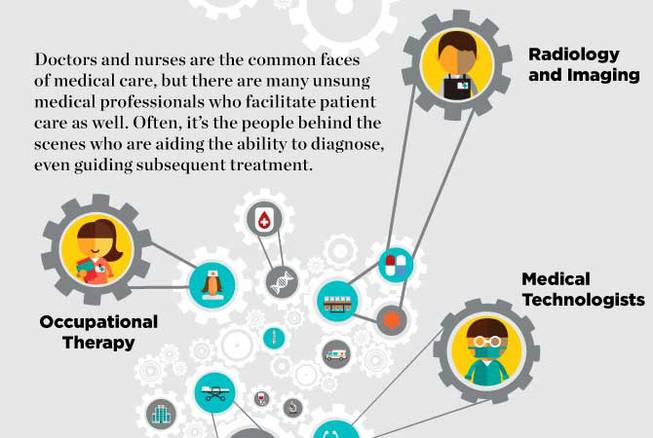
Sunday, April 19, 2015 | 2 a.m.
Doctors and nurses are the common faces of medical care, but there are many unsung medical professionals who facilitate patient care as well. Often, it's the people behind the scenes who are aiding the ability to diagnose and even guiding subsequent treatment.
Occupational Therapy
What they do: The goal of occupational therapy is to assess and improve a patient’s function level after a medical event that affects his or her physicality, cognition or both. That could be anything from a shoulder dislocation to a massive stroke.
If it substantially alters the way someone goes about daily life, an occupational therapist can help.
“A lot of people don’t realize that occupational therapy is more than something to get you back to work. It’s meant to get you back to your life,” occupational therapist Blair Tompkins said. Summing up all that occupational therapists do is difficult, because their goals adhere solely to the goals of their patients, which can be endlessly varied.
Why it’s important: Ultimately, occupational therapists find strategies for recovering patients and help them break down their goals into manageable and buildable tasks.
“A patient might not be able to brush their teeth, so I’ll put toothpaste on the toothbrush and put the toothbrush in the patient’s hand — that’s where we’ll start,” Tompkins said. “For as many jobs as many of us have, one of the most important is the full-time job of caring for yourself.”
Occupational therapists also assign assistive and adaptive devices — including such items as a long-handled shoehorn, bath sponges, wheelchairs and canes — to help aid patients’ lives.
Something you don’t know about the job:Occupational therapists also do a lot of physical therapy-like exercises, although they generally work most with hands, wrists, necks and arms, whereas physical therapists work more with hips, knees and legs.
— Blair Tompkins, occupational therapist at Southern Hills Hospital and Medical Center
Radiology and Imaging
What they do: Medical imaging includes a wide range of types of images with different purposes, but they all help doctors diagnose.
“Most technologists start with radiology and then branch out to other modalities, such as ultrasound, MRI, CT, mammography, etc.,” Director of Imaging Services Trish Alley said. “We also do fluoroscopy imaging during surgery, which is like a real-time X-ray, so the surgeons can see what they’re doing while they’re operating.”
Why it’s important: The goal of an X-ray technologist is to capture suitable images for a radiologist.
“Our job is to ensure we obtain the best quality image while maintaining a low dose of radiation for the patient,” Alley said. There are many contributing factors to obtaining good X-rays, but one of the most challenging and necessary is getting the desired image while accounting for the patient’s limitations.
Something you don’t know about the job: An X-ray for a dislocated shoulder might sound simple enough, but an X-ray technologist must consider the different angles of the shoulder the radiologist needs to see, depending on whether it’s a front dislocation or a back dislocation and if any tendons or ligaments were torn, and how the patient is able to position the injured shoulder to expose that angle.
“Medical imaging is part art, part science. The science is knowing your techniques, positioning, radiation safety and the physics of what you’re doing. The art is that each patient is different, and you need to be creative to get the images the radiologist needs.”
— Trish Alley, director of imaging services at Southern Hills Hospital and Medical Center
Medical Technologists
What they do: Medical technologists process and analyze laboratory results, and while they stay behind the scenes for most patients, their findings are the foundation of most diagnoses and subsequent treatments.
“Anything you can imagine from the body — urine, blood, sputum, feces, tissue — we’ll analyze,” Assistant Administrator Stephanie Miller said. “While we have no patient contact, we get to know the patients really well through their samples.”
Why it's important: Many laboratory tests are automated now, as opposed to time-consuming manual tests. It’s the medical technologist’s job to ensure the tests are being conducted properly and to interpret the results.
“Before testing the specimen, we have to do quality control. We have a ton of regulations we need to follow to make sure we’re getting quality results,” Manager of Laboratory Services Vaughn Fredieu said. From there, the results are analyzed and interpreted. Then the lab sends the results to the doctor, who uses them as a basis for patient treatment.
Something you don’t know about the job: “We get a lot of things you wouldn’t expect,” Miller said. “If someone’s lost a foot for instance, we’ll get the whole foot for testing. We do all the tumor biopsies; we’ll get parts of organs, fingers, toes, extracted pacemakers or medical screws. Really, anything that can come from the body, we’ll test.”
“While we don’t work in direct contact with patients, the specimens in the lab are like our patients.”
— Vaughn Fredieu, manager of laboratory services at Southern Hills Hospital and Medical Center

Join the Discussion:
Check this out for a full explanation of our conversion to the LiveFyre commenting system and instructions on how to sign up for an account.
Full comments policy